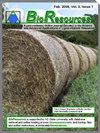Effect of processing temperature and polymer types on mechanical properties of bamboo fiber composites
IF 1.6
4区 农林科学
Q2 MATERIALS SCIENCE, PAPER & WOOD
引用次数: 0
Abstract
Bamboo fiber was extracted after alkaline treatment, and the mechanical properties of fibers and polymer composites were measured. The results showed that the strength of bamboo fiber was higher when the diameter was smaller. Smaller diameter bamboo fibers were dense, while larger diameter ones were composed of vascular bundles, which contained inside voids and outside parts having insufficient lignification. Tensile tests were conducted on bamboo fibers after heating at constant temperatures, and a significant decrease in mechanical properties was observed at heating temperatures above 250 °C. Bamboo fibers were compounded with PE, PA12, ABS, PA6, and biobased PC (Durabio), and injection-molded to prepare the composite specimens for flexural testing. The composite of polyethylene with 30 wt% bamboo exhibited considerably high flexural modulus compared to pure PE. Nevertheless, a large plastic deformation, which was equivalent to that of pure PE was observed. In other polymer composites, those flexural moduli increased, and degree of plastic deformation decreased dramatically, leading to brittleness. For PA6, which was molded above 250 °C, the increment in flexural modulus by fibers was less than the other composites due to the thermal decomposition of the fibers.加工温度和聚合物类型对竹纤维复合材料力学性能的影响
对碱处理后的竹纤维进行提取,并对纤维和聚合物复合材料的力学性能进行测定。结果表明,竹纤维直径越小,其强度越高。直径较小的竹纤维致密,而直径较大的竹纤维由维管束组成,维管束内部有空隙,外层木质化不足。对竹纤维进行恒温加热后的拉伸试验,在250℃以上的加热温度下,观察到其力学性能明显下降。将竹纤维与PE、PA12、ABS、PA6和生物基PC (Durabio)复合,注塑成型,制备复合材料试件进行抗弯试验。与纯PE相比,聚乙烯与30%竹子的复合材料具有相当高的弯曲模量。然而,观察到与纯PE相当的大塑性变形。在其他聚合物复合材料中,弯曲模量增加,塑性变形程度急剧下降,导致脆性。对于250℃以上成型的PA6,由于纤维的热分解作用,纤维对其弯曲模量的增量小于其他复合材料。
本文章由计算机程序翻译,如有差异,请以英文原文为准。
求助全文
约1分钟内获得全文
求助全文
来源期刊

Bioresources
工程技术-材料科学:纸与木材
CiteScore
2.90
自引率
13.30%
发文量
397
审稿时长
2.3 months
期刊介绍:
The purpose of BioResources is to promote scientific discourse and to foster scientific developments related to sustainable manufacture involving lignocellulosic or woody biomass resources, including wood and agricultural residues. BioResources will focus on advances in science and technology. Emphasis will be placed on bioproducts, bioenergy, papermaking technology, wood products, new manufacturing materials, composite structures, and chemicals derived from lignocellulosic biomass.
 求助内容:
求助内容: 应助结果提醒方式:
应助结果提醒方式:


